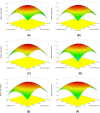Melanin-templated rapid synthesis of silver nanostructures
- PMID: 24885756
- PMCID: PMC4038705
- DOI: 10.1186/1477-3155-12-18
Melanin-templated rapid synthesis of silver nanostructures
Abstract
Background: As a potent antimicrobial agent, silver nanostructures have been used in nanosensors and nanomaterial-based assays for the detection of food relevant analytes such as organic molecules, aroma, chemical contaminants, gases and food borne pathogens. In addition silver based nanocomposites act as an antimicrobial for food packaging materials. In this prospective, the food grade melanin pigment extracted from sponge associated actinobacterium Nocardiopsis alba MSA10 and melanin mediated synthesis of silver nanostructures were studied. Based on the present findings, antimicrobial nanostructures can be developed against food pathogens for food industrial applications.
Results: Briefly, the sponge associated actinobacterium N. alba MSA10 was screened and fermentation conditions were optimized for the production of melanin pigment. The Plackett-Burman design followed by a Box-Behnken design was developed to optimize the concentration of most significant factors for improved melanin yield. The antioxidant potential, reductive capabilities and physiochemical properties of Nocardiopsis melanin was characterized. The optimum production of melanin was attained with pH 7.5, temperature 35°C, salinity 2.5%, sucrose 25 g/L and tyrosine 12.5 g/L under submerged fermentation conditions. A highest melanin production of 3.4 mg/ml was reached with the optimization using Box-Behnken design. The purified melanin showed rapid reduction and stabilization of silver nanostructures. The melanin mediated process produced uniform and stable silver nanostructures with broad spectrum antimicrobial activity against food pathogens.
Conclusions: The melanin pigment produced by N. alba MSA10 can be used for environmentally benign synthesis of silver nanostructures and can be useful for food packaging materials. The characteristics of broad spectrum of activity against food pathogens of silver nanostructures gives an insight for their potential applicability in incorporation of food packaging materials and antimicrobials for stored fruits and foods.
Figures










Similar articles
-
Applications of nanotechnology in food packaging and food safety: barrier materials, antimicrobials and sensors.J Colloid Interface Sci. 2011 Nov 1;363(1):1-24. doi: 10.1016/j.jcis.2011.07.017. Epub 2011 Jul 23. J Colloid Interface Sci. 2011. PMID: 21824625 Free PMC article.
-
3, 4-dihydroxy-L-phenylalanine-derived melanin from Yarrowia lipolytica mediates the synthesis of silver and gold nanostructures.J Nanobiotechnology. 2013 Jan 30;11:2. doi: 10.1186/1477-3155-11-2. J Nanobiotechnology. 2013. PMID: 23363424 Free PMC article.
-
Melanin-gamma rays assistants for bismuth oxide nanoparticles synthesis at room temperature for enhancing antimicrobial, and photocatalytic activity.J Photochem Photobiol B. 2017 Aug;173:120-139. doi: 10.1016/j.jphotobiol.2017.05.030. Epub 2017 May 23. J Photochem Photobiol B. 2017. PMID: 28570907
-
Nanotechnology tools for antibacterial materials.Nanomedicine (Lond). 2013 May;8(5):807-21. doi: 10.2217/nnm.13.63. Nanomedicine (Lond). 2013. PMID: 23656266 Review.
-
Melanin as a Photothermal Agent in Antimicrobial Systems.Int J Mol Sci. 2024 Aug 18;25(16):8975. doi: 10.3390/ijms25168975. Int J Mol Sci. 2024. PMID: 39201661 Free PMC article. Review.
Cited by
-
A Yarrowia lipolytica Strain Engineered for Pyomelanin Production.Microorganisms. 2021 Apr 14;9(4):838. doi: 10.3390/microorganisms9040838. Microorganisms. 2021. PMID: 33920006 Free PMC article.
-
Effect on Human Vascular Endothelial Cells of Au Nanoparticles Synthesized from Vitex mollis.ACS Omega. 2021 Sep 16;6(38):24338-24350. doi: 10.1021/acsomega.1c01506. eCollection 2021 Sep 28. ACS Omega. 2021. PMID: 34604617 Free PMC article.
-
Melanin production by Pseudomonas sp. and in silico comparative analysis of tyrosinase gene sequences.BioTechnologia (Pozn). 2021 Dec 22;102(4):411-424. doi: 10.5114/bta.2021.111106. eCollection 2021. BioTechnologia (Pozn). 2021. PMID: 36605604 Free PMC article.
-
Facile aerobic construction of iron based ferromagnetic nanostructures by a novel microbial nanofactory isolated from tropical freshwater wetlands.Microb Cell Fact. 2017 Oct 11;16(1):175. doi: 10.1186/s12934-017-0789-3. Microb Cell Fact. 2017. PMID: 29020992 Free PMC article.
-
Biosynthesis of catechol melanin from glycerol employing metabolically engineered Escherichia coli.Microb Cell Fact. 2016 Sep 22;15(1):161. doi: 10.1186/s12934-016-0561-0. Microb Cell Fact. 2016. PMID: 27659593 Free PMC article.
References
-
- Appendini P, Hotchkiss JH. Review of antimicrobial food packaging. Innov Food Sci Emerg Technol. 2002;3:113–126. doi: 10.1016/S1466-8564(02)00012-7. - DOI
-
- U.S. Food and Drug Administration. FDA approved Food Contact Substances. http://www.fda.gov.
Publication types
MeSH terms
Substances
LinkOut - more resources
Full Text Sources
Other Literature Sources
Medical
Molecular Biology Databases
Research Materials
Miscellaneous

